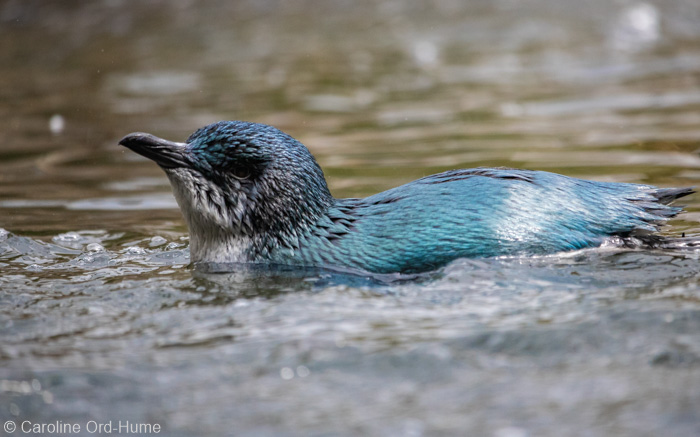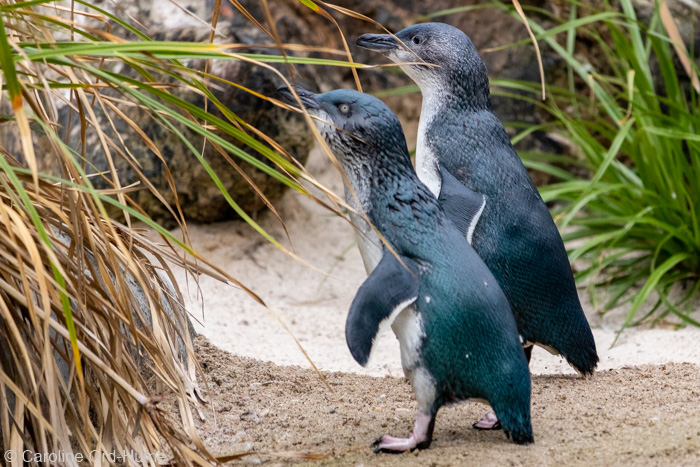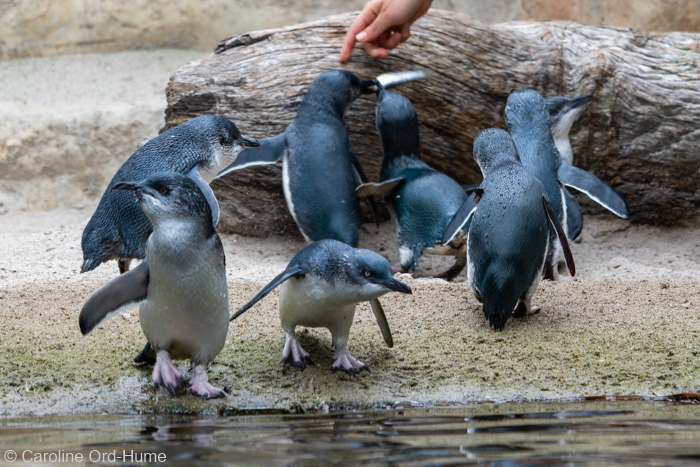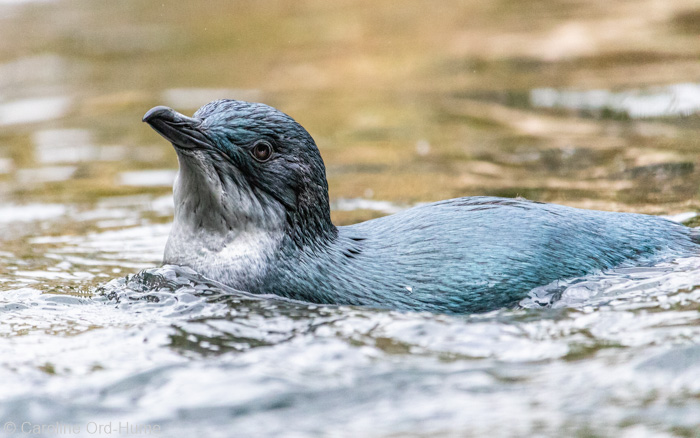Little Penguin kororā - Little Blue Penguin
You may guess from the name Little Penguin (Eudyptula minor) that these are the smallest penguins in the world. They are little blue penguins commonly found around the coasts of New Zealand and surrounding islands.
These small penguins are often living close to humans, in or near towns, and will sometimes make their nests under buildings on the coast. Being nocturnal this can cause some disturbance at night if they become noisy.
Here are some Little Penguin facts...
Little Penguin

Little Penguin / korora (Eudyptula minor) Family: Spheniscidae
Other Names Include: little blue penguin, kororā, korora, blue penguin, white-flippered penguin, fairy penguin
Species Variations
There are no recognised subspecies. Any morphological differences across regions are minor and not genetically diverse.
Little Penguin Description and Identification
Little Penguins are the smallest penguins in the world with a length of just 25-33 cm and weight of around 1 kg.
They have medium to dark blue upper colouring, with white underparts, and dark blue upper face. There is some variation of the depth of blue in different regions with some being of a paler blue such as those on the Banks Peninsula and in the northern parts of Canterbury. The flippers of these birds also have slightly different widths of white on their flippers on the front and back edges.
Little Penguin have dark grey bill, a hazel or blue/grey iris, with off white legs and feet.
The male penguins are usually a bit bigger than the females and have stronger bills.
Juvenile penguins are usually brighter blue and smaller than mature penguins.
See images for colouring identification.
Distribution and Little Blue Penguin Habitat
The population of Little Blue Penguin is common to a lot of the coast of New Zealand along with islands offshore. Islands provide better protection from human disturbance and predators on the mainland unless where additional protection/conservation measures have been taken.
Largest Penguin Colonies
The most well known and largest colonies of Little Penguin in New Zealand are
- Oamau Blue Penguin colony
- Banks Peninsula
- Motunau Island
- Pohatu Bay
Distribution of Little Penguins on the North Island, South Island, Stewart Island, the Chatham Islands is wide around all the coasts and other islands offshore.
During the breeding season Blue Penguins generally stay within a 25 km distance of the shore but out of breeding season their travel can take them further out to sea.
Breeding
Little Penguin breed in pairs or different sized colonies, making their nests near to the sea in a wide variety of places such as burrows, caves, pipes, under buildings, in log piles, practically anywhere they can make a little home resembling a burrow.
The adult pair shares the rearing of chicks and they are the only penguin species that can produce a second clutch during breeding season, although not many do.
Pair of Little Penguins

Eggs are laid between July and the middle of November, and on rare occasions as late as the end of the year. Egg incubation takes up to 36 days. Chicks are looked after for 18-38 days, and the juvenile penguins fledge at around 7-8 weeks. Little Penguins will often return to the same nests.
Main Little Penguin breeding locations in New Zealand are
- Banks Peninsula - Christchurch
- Chatham Islands and surrounding islands
- Cook Strait islands
- Fiordland
- Foveaux Strait
- Hauraki Gulf islands
- Marlborough Sounds
- Motunau Island
- Oamaru
- Otago Peninsula, Dunedin
- Stewart Island/Rakiura
- Wellington Harbour
- West Coast, South Island
These tiny penguins can also be found in the south west and south east of Australia, commonly known as Fairy Penguins in Australia.
What do Little Penguin Eat
In the active breeding season, Little Penguins will search for food up to around 20 km from their colony and dive in water up to 50 metres depth.
What do Little Penguins eat? They forage for a diet consisting of small fish, squid, and small crustaceans. Of importance in their diet are Arrow Squid, Graham’s Gudgeon, Red Cod, Sprat, along with Ahuru and Stomatopod larvae.
Survival of Little Blue Penguins
Although numerous and widespread around New Zealand, Little Penguins are declining in some colonies. Main threats to survival vary across the country but include introduced predators, habitat degradation, climate change, fisheries, oil pollution, and potentially also collection of chicks or eggs.
The image below shows evidence of injuries often from dogs. The penguin in the front left has one flipper missing, the lower half of it's beak has been torn off, and it's left eye is missing.
Little Blue Penguins Feeding Time at the National Aquarium of New Zealand Napier

On Land Threats
Predators
Little Penguin species are in decline on land in New Zealand partially due to the detrimental impact of introduced predators such as dogs, cats, stoats and ferrets. The biggest threat is from dogs…. as is usual with many species right across the world!
Where there is no predator control colonies can decline in numbers. Just one out of control dog can cause immense damage to a colony over a period of time once they get a taste for penguin and know where they can be found! When out with a dog/s make sure dogs are allowed at the location, keep dogs under control, put dogs on a lead where there is wildlife, and notify the Department of Conservation (DOC) if you see dogs harassing wildlife. (The emergency DOC phone number provided is below).
Control of predators in areas such as Banks Peninsula, Oamaru, and Wellington Harbour, along with provision of nesting boxes in safe areas leads to a growth in the populations.
Read more about Predators of New Zealand
Humans
Obviously human impact from introducing domestic predators such as cats and dogs is one thing, but buildings, roads and traffic, boating, and other human activities all play their part in the decline of these wonderful Little Penguins.
Important breeding colonies on the mainland are impacted by human encroachment. If owners of properties find the penguins to be a nuisance they will sometimes remove the penguins or block them from their regular nest site.
Adult Little Penguins get injured or killed by vehicles on coast roads where the road has been built between the sea and the historic nesting ground. Roads around Wellington Harbour and in North Westland are two such examples.
Little Blue Penguins are nocturnal when on land. They go out to sea during the day to hunt for food and return to land at night. As you can imagine, having to cross a coast road to get home in the evening is extremely risky for small blue penguins and often ends in disaster.
Off Shore Threats
Little Penguins are in danger of becoming entangled in set fishing nets at sea, some boating activities, and reduction of their food sources due to impact of fishing.
Little Penguin Conservation
Little penguins are protected by the Wildlife Act.
National Aquarium of New Zealand Napier

Some examples of blue penguin conservation in New Zealand are
National Aquarium of New Zealand in Napier, where they care for sick or injured Little Penguins.
Tiritiri Matangi Open Sanctuary
To find out what you can do to help in conservation of these rare native birds visit the Department of Conservation (DOC): https://www.doc.govt.nz/nature/native-animals/birds/birds-a-z/penguins/little-penguin-korora/
DOC Emergency Number
If you see any New Zealand wildlife being harmed by anyone, or any other animal such as a dog, please don't hesitate to call this number and report it immediately. 0800 362 468
Other New Zealand Birdlife and Wildlife
List of New Zealand Native Birds and List of New Zealand Animals, Land and Marine
References
For further reading